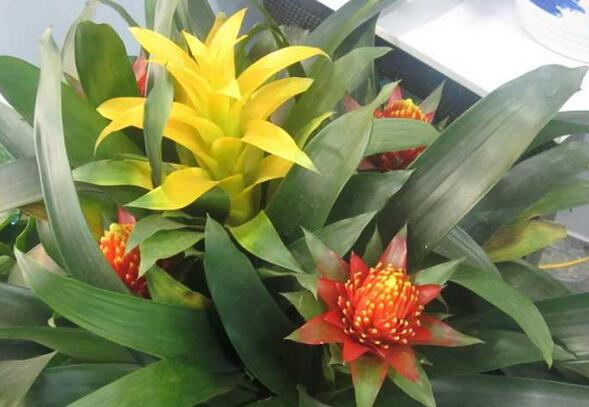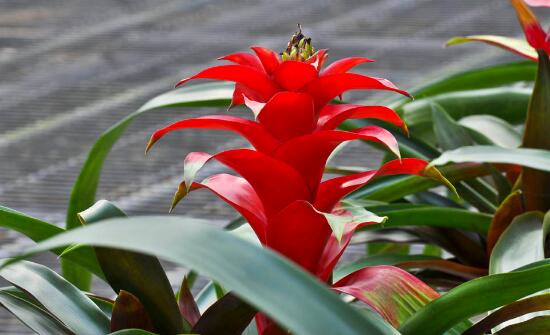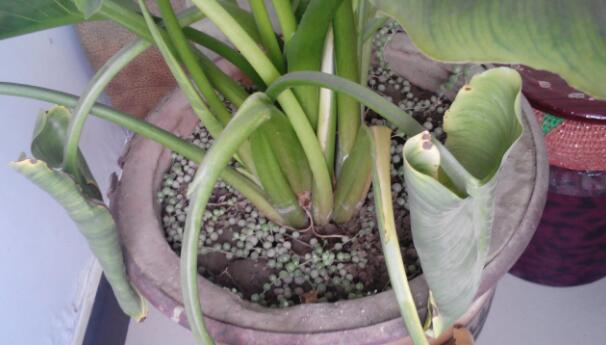What about the insects growing in the pineapple flower? pest control of the pineapple flower / 3 insect pests and 3 diseases
The beauty of pineapple is reflected in the flower. After all, it only blossoms once a year. But because some flower friends maintain improperly, pineapple flowers will be infested by insects, resulting in a decline in ornamental, then how to grow bugs in pineapple flowers? In fact, there is no need to panic, we just need to find out what kind of pest it is, and then solve the problem. The following are the common pest control of pineapple, let's go and have a look.
What about the worms growing in the pineapple blossom? spray and kill

In the culture method of pineapple, it has been introduced that it needs to pay attention to in the process of growth. if the flower friends do not pay attention, the insects will come to the door. What about the bugs in the pineapple flowers? find out what kind of insects they are, and then solve them. The following are the common pests of three species of pineapple, as follows:
1. Scale insects
The shell insect harms all flowers, so it is also one of the pests of pineapple flowers. It is observed that scale insects mainly harm the leaves of pineapple flowers, and when they are serious, the leaves will yellowing, withering and even falling. The solution to the yellowing of pineapple leaves has been introduced before. let's take a look at the solution to scale insects.
Solution: when it is found that it is harmful to scale insects, it should be solved immediately. A small amount of shell insects can be scraped off directly. When there are a large number of scale insects, 50% of parathion can be used for spray killing.
2. Spodoptera litura
Spodoptera litura, also known as Spodoptera litura, is also one of the pests of pineapple flowers. It usually hides in the dark places such as basin soil and the bottom of the basin during the day, and comes out in the evening to feed on the petals, stamens and pistils of pineapple flowers.
Solution: when the bug is found, it should be sprayed immediately. As for what kind of medicine is used, the insect-resistant pesticides on the market can be used.
3. Red spider
Red spider, one of the common insect pests of pineapple flowers, mainly lives on the back of leaves or the base of leaf axils of pineapple flowers, and will prick and suck leaves, buds and leaf sap, affecting normal growth and development. When attacked by the insect, the light ones will affect the appearance, and in serious cases, it will lead to the death of the whole plant.
Solution: the red spider is small, which is difficult for us to detect with the naked eye, but once found, it should be solved quickly. When there are a small number of bugs, rinse with clean water; for too long, spray 1000 times of dimethoate solution, once every 4 days, 2-3 times in a row.
Diseases of pineapple flowers and their solutions
There are bugs in the pineapple flowers. We should know what to do after reading the above contents. However, in addition to being attacked by insects, the disease also endangers pineapple flowers all the time, and there are three main diseases of pineapple flowers, namely, heart rot, root rot and leaf tip yellowing. The specific symptoms and solutions are as follows:
1. Heart rot
The disease is not common, but it is one of the common diseases of pineapple. When suffering from this disease, the tissue at the base of the pineapple mosaic tube becomes soft and rotten, with a bad smell. If you do not move it for a long time, the leaf tube will fall down by itself.
2. Root rot
After suffering from the disease, the root tip of pineapple will turn black and brown or rot, and do not grow lateral roots, thus affecting the absorption of water and fertilizer by the plant, resulting in slow growth and weakening of pineapple. It is understood that heart rot or root rot may occur in the season of high temperature and humidity.
Solution to heart rot and root rot: after discovering the above symptoms, flower friends can irrigate the leaf tube with 75% oxidize manganese zinc 400 times or 40% ethylphosphine aluminum 400 times, once a month, 3 times in a row.
3. Yellowing and withering of leaf tip
Another disease of pineapple, it is generally related to water, once the improper watering, or low air humidity, it will lead to high salinity in the soil and cause salt damage. At this time, the leaf tip yellowing and withering will come to the door, the light ones will lead to the yellowing of the leaves, and the serious ones will die directly.
Prevention and treatment: when watering, try to choose less salty water, if you choose household water, it should be used after exposure to the sun.
How to deal with calla lilies growing insects, calla lotus diseases and insect pests control / 3 insect pests and 3 diseases
Calla lilies, a kind of flowers with beautiful meaning and beautiful colors, are the favorite of modern people. However, due to improper maintenance, many people raise calla lilies will have a variety of problems, such as being attacked by insects, then how to deal with calla lilies? In fact, it is very simple, which kind of bug is encountered, and then solve the problem. The following is the pest control of calla lilies. Follow the editor to have a look.
First, how to deal with the calla lily worm, spray and kill it.
Horseshoe lotus has a long flowering period and is a highly ornamental flower, so once it is infested by insects, it will seriously affect its beauty. As for how to deal with calla lilies, in fact, it is not difficult, we just need to carefully find out which kind of bug, and then solve it.
(1) three major insect pests of calla lilies
When calla lilies are kept at home, what they fear most is the growth of worms. Good flowers turn into withered branches and leaves, which is really a headache. It is understood that there are mainly three kinds of insect pests of calla lilies: shell insects, two-point leaf mites and species flies. The specific symptoms and solutions are as follows:
1. Scale insects
Scale insect, one of the main pests of calla lilies, mainly harms the leaves of pineapple flowers, which yellowing, withering and even falling. What if the calla lily leaves turn yellow? I've already introduced it before, but I won't say much here.
Solution: when you find the above symptoms and confirm that they are scale insects, flower friends should solve them immediately. A small amount of shell insects can be scraped off directly. When there are a large number of scale insects, 50% of parathion can be used for spray killing.
2. Tetranychus urticae
The insect, also known as cotton red spider, is also one of the common pests of calla lilies. It usually absorbs leaf juice on the back of calla lilies leaves. When attacked by two-point spider mites, the light leaves turn red, such as fire, heavy leaves fall.
Solution: when the pest is found, the diseased leaves should be removed and treated centrally; it can also be solved by spraying 1000 times of dicofol or 2000 times of dicofol.
3. Seed fly
One of the main pests of calla lilies, it is also a kind of maggot that erodes the seedlings during the larval stage, causing it to rot and die. Once entangled by this bug, the consequences are very serious.
Solution: when the pest occurs, it can be sprayed with some insecticidal powder, or its soil and seeds can be treated with chemicals as soon as they are ready to be planted.
(2) four major diseases of calla lilies
Calla lilies grow worms how to deal with, read the above content we should know how to do it! However, in addition to being attacked by insects, the disease is also harmful to calla lilies all the time, and there are three main diseases of calla lilies: grey mold, soft rot and leaf spot. The specific symptoms and solutions are as follows:
1. Grey mold
The disease is one of the diseases of calla, which mainly harms the leaves, pedicels and flowers of calla. Symptoms: the leaves will produce yellow-green to dark green water-like plaques, gradually expand, when wet soft rot, the affected part of the gray, khaki mildew layer.
Solution: when the disease is found, the diseased leaves in the toilet should be removed in time to avoid contact with infection. If necessary, 50% carbendazim 500 times or 75% chlorothalonil 500 times can be sprayed, and it can be basically solved after a few times.
2. Soft rot
When suffering from the disease, calla lilies near the surface will occur soft rot detachment, root rot, the whole plant suddenly wilted and died. If the leaf is sick, it will become soft and wet rot; when the pedicel is damaged: the flower turns brown, the pedicel soft rot falls off, bacterial disease.
Solution: when it is found that the disease is affected, flower friends should remove the diseased bulbs and disinfect the soil with 40% formaldehyde around the diseased plant.
3. Leaf spot
Leaf spot, one of the diseases of calla, often occurs in the process of growth. Symptoms: small lesions on the leaves, nearly round, gray, and gradually expanding in combination with irregular large rotten spots, sometimes opposing flowers and pedicels.
Solution: when the disease is found, flower friends should remove the residue of diseased leaves in time to avoid too much water. In severe cases, use 1000-1500 times of emulsified oil, or 80% Dasheng 500 times, spray 25% 2-3 times every 7-15 days.
Ji pineapple leaves how to change color, how to do, its diseases and insect pests how to control Ji pineapple leaves are very beautiful, there are clear lines, with color vertical and horizontal stripes. It has colorful leaves and is a good home-grown foliage plant. But it is also very fragile, vulnerable to diseases and insect pests, but also encounter leaf discoloration. Today I will take you to understand the diseases and insect pests of Ji pineapple and the causes of leaf discoloration.
The reason for the discoloration of leaves
Ji pineapple leaves were originally purplish red, turned green because of the lack of sunlight, plants can not carry out photosynthesis, lack of lycopene and chlorophyll, so the color changes gradually. If the indoor location is too dark, the markings on the leaves will gradually disappear, and the leaf color will become dim and lose its ornamental value. In addition, too strong direct light will burn the leaves and miscellaneous spots will appear on the leaves. Ji pineapple is not hardy, so the lower the temperature in winter, the darker the leaf color will be. The leaf tip dries up because the summer air humidity is low, the evaporation is relatively large, and the leaves are easily short of water, which leads to the leaf tip drying up.
Solution method
Ji pineapple likes the semi-overcast environment and is suitable for growing under the condition of 20 ℃-25 ℃. It should be placed near the sunny windowsill and can receive up to 4 hours of direct sunlight every day, but avoid strong sunlight. The position of Ji pineapple should be changed according to the change of season. The lowest room temperature in winter should not be lower than 15 ℃, and Ji pineapple is vulnerable to freezing injury when it is lower than 10 ℃. During the peak growth period, Ji pineapple can make its leaves bright by applying organic liquid fertilizer once every 10 days and alum solution once or twice a month. If you don't apply more nitrogen fertilizer in daily life, the leaf pattern will become dim. In order to prevent the leaf tip from drying up, to keep the basin soil moist, spray water to the leaf surface once or twice a day, and the cup-shaped part of the leaf seat can be filled with water.
Pest control
The diseases of Ji pineapple include anthracnose, gray mold, middle spot, stem rot, wilt and so on.
Prevention and cure method
For anthrax, 500-fold solution of 25% trimethalin wettable powder or 600-fold solution of 27% copper noble suspension and 160-fold Bordeaux solution should be used for prevention and control. Once every half a month, a total of 2-3 times.
In view of Botrytis cinerea, indoor humidity should be reduced, watering had better be carried out in the morning on sunny days, watering on rainy days should not be avoided, and ventilation should be released later in the morning on sunny days to ensure indoor air circulation.
For stem rot, 38% carbendazim 1000 times or thiram 1000 times were sprayed on Ji pineapple from mid-May to July, respectively.
Insect pest
The insect pests of Ji pineapple are seriously damaged by pink scale and shell insects. Pink scale is a small juice-sucking insect with white sticky powder outside the body, which can harm crops, fruit trees, gardens, forests and pastures. Scale insects will absorb the sap of plants, and in serious cases, it will cause death of the whole plant, and its secretions may also cause coal fouling disease, which is very harmful.
Prevention and cure method
For pink scale, if it is not a particularly serious infection, you can get rid of it by hand, spray it with strong water (be careful not to hurt Ji pineapple), or rinse the plant with water and methylated alcohol 1:1 solution. This can not only wash away the bugs, but also kill those that can not be washed away.
In the process of breeding Ji pineapple, it is found that there are shell insects on individual leaves, which can be gently brushed off with a soft brush, or combined with pruning to cut off insect branches and leaves. It is required to brush clean, cut clean, focus on burning, do not throw.
The above are the causes and methods of discoloration of Ji pineapple leaves and the prevention and control of diseases and insect pests. I hope it can be helpful to the majority of flower friends, and please continue to pay attention to the succulent flower bed and learn more about flower conservation.
- Prev

What if there are insects in the flowers? pest control / drug spraying at the head of good luck
But its effect is amazing, not only can eat whitening, medicine can also cure all kinds of diseases, so many flower friends choose to raise it. However, in the process of breeding, because of improper maintenance, good luck will be plagued by insect pests, so what should we do when good luck grows bugs? The following is the prevention and control of plant diseases and insect pests
- Next

How to deal with calla lilies growing insects, calla lotus diseases and insect pests control / 3 insect pests and 3 diseases
Calla lilies, a kind of flowers with beautiful meaning and beautiful colors, are the favorite of modern people. However, due to improper maintenance, many people raise calla lilies will have a variety of problems, such as being attacked by insects, then how to deal with calla lilies? In fact, it is very simple, which kind of bug is encountered, and then you can solve it.
Related
- Fuxing push coffee new agricultural production and marketing class: lack of small-scale processing plants
- Jujube rice field leisure farm deep ploughing Yilan for five years to create a space for organic food and play
- Nongyu Farm-A trial of organic papaya for brave women with advanced technology
- Four points for attention in the prevention and control of diseases and insect pests of edible fungi
- How to add nutrient solution to Edible Fungi
- Is there any good way to control edible fungus mites?
- Open Inoculation Technology of Edible Fungi
- Is there any clever way to use fertilizer for edible fungus in winter?
- What agents are used to kill the pathogens of edible fungi in the mushroom shed?
- Rapid drying of Edible Fungi

